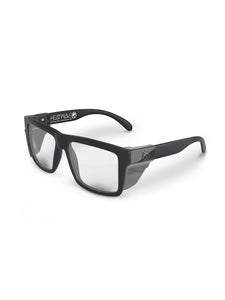It also comes in three different shell sizes to optimize fit. And maybe most importantly, it carries both DOT and ECE safety certifications.
The Bullitt eliminates many objections to wearing a full-face helmet. It’s lightweight and offers a huge field of view, great for heads-up city riding and general all-around safety. It’s also highly adaptable—run it with the included straight clear shield or with one of many straight or bubble-shaped aftermarket shields. Plus, thanks to a slick leather-clad magnet tab, the shield can be cleanly removed and the helmet can be worn with glasses or goggles of your choice.
Besides its modern safety standards it also has some creature comforts that separate it from other retro full-face helmets. Note the circular steel-mesh vents in place of the snaps found. There’s also a hidden switch inside the chinbar that toggles airflow on and off. And then there’s the Bullitt’s superb fit. The helmet's fit is optimized for an intermediate-oval head shape—most of the North American market, and it comes in three different shell sizes (XS/S, M/L XL/XXL), each with completely removable and washable pads.
Certifications: DOT and ECE 22.05
Sizes: XS, S, M, L, XL, XXL
Weight: 1,400 grams
The Bullitt slots into a growing and healthy market of retro-looking full-face helmets, and we like it for its functionality, full feature set, and reassuring safety rating. Its most notable competitors are the $150 Biltwell Gringo, which came out last summer, and the $1,200, over-the-top oxblood-leather-lined Ruby Castel, which has been out for a year now. Coming in at $399 with an integrated hinged shield included (both the Biltwell and the Ruby come sans optical protection) the Bullitt is priced well, and priced to sell.
Bonus trivia: The Bullitt has been on the drawing board since 2009. And it wasn’t Bell’s drawing board, but that of an industrial design student named Chad Hodge, who spent half a year developing the Bullitt as his senior thesis. See here for our full interview with Hodge.
It also comes in three different shell sizes to optimize fit. And maybe most importantly, it carries both DOT and ECE safety certifications.
The Bullitt eliminates many objections to wearing a full-face helmet. It’s lightweight and offers a huge field of view, great for heads-up city riding and general all-around safety. It’s also highly adaptable—run it with the included straight clear shield or with one of many straight or bubble-shaped aftermarket shields. Plus, thanks to a slick leather-clad magnet tab, the shield can be cleanly removed and the helmet can be worn with glasses or goggles of your choice.
Besides its modern safety standards it also has some creature comforts that separate it from other retro full-face helmets. Note the circular steel-mesh vents in place of the snaps found. There’s also a hidden switch inside the chinbar that toggles airflow on and off. And then there’s the Bullitt’s superb fit. The helmet's fit is optimized for an intermediate-oval head shape—most of the North American market, and it comes in three different shell sizes (XS/S, M/L XL/XXL), each with completely removable and washable pads.
Certifications: DOT and ECE 22.05
Sizes: XS, S, M, L, XL, XXL
Weight: 1,400 grams
The Bullitt slots into a growing and healthy market of retro-looking full-face helmets, and we like it for its functionality, full feature set, and reassuring safety rating. Its most notable competitors are the $150 Biltwell Gringo, which came out last summer, and the $1,200, over-the-top oxblood-leather-lined Ruby Castel, which has been out for a year now. Coming in at $399 with an integrated hinged shield included (both the Biltwell and the Ruby come sans optical protection) the Bullitt is priced well, and priced to sell.
Bonus trivia: The Bullitt has been on the drawing board since 2009. And it wasn’t Bell’s drawing board, but that of an industrial design student named Chad Hodge, who spent half a year developing the Bullitt as his senior thesis. See here for our full interview with Hodge.










